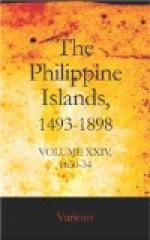In the present year the vessel “San Juan” returned, the ill-fortune of which was feared, because the almiranta had put back to port. It gave report of its voyage, whereupon the order voted what was important. [79] They appointed a procurator who went to Espana. This was the father reader, Fray Pedro de la Pena, [80] who was prior of Macabebe in Pampanga. He took passage on the flagship “San Luis.” In the almiranta embarked another father, from Valencia, named father Fray Vicente Lidon. These vessels left the port of Cavite on August 4. They put back to the same port to lighten, and set sail again as heavily laden as before. They experienced no better voyage than the last ones had; for, besides putting back, they did not lack misfortunes. The flagship cut down its mast on the high sea, and was all but lost. The other vessel also suffered greatly, and between them both they threw overboard more than one hundred and forty [dead] people, while the others were like to die of hunger, for the voyage lasted seven and one-half months. Nueva Espana no longer expected them, and therefore despatched [to the islands] two small vessels from Peru, in which came the visitor of the islands, Don Francisco de Rojas. Both vessels suffered greatly. They lost their rudders, and their arrival was a miracle. It is quite apparent that the Lord is very merciful toward the islands. We surmise that these vessels arrived, one in July and the other in August of 1631. The worst thing resulting to the order in what happened to the vessels was, that no one would take passage on the ships, so that the province came to a condition of the utmost peril. For, if procurators are lacking in Espana, there is no hope of getting religious; and the religious who are here now are dying daily. For never have I seen a triennium when there were not more than twenty deaths, and sometimes even thirty; while few are invested with the habit. Thus, perforce, the province is always in need of men.
Nevertheless, I, who had always been desiring to go to Espana, at last obtained my wish this year of 1631, under the greatest strife and oppositions that can be told; but I will not speak of them, as they are personal, although a not small history might be made of them. Finally I embarked in the flagship (where I went as vicar), in which no other priest embarked. The ship was a new one, and had been built in Cavite, during the residence of Governor Don Juan Nino de




